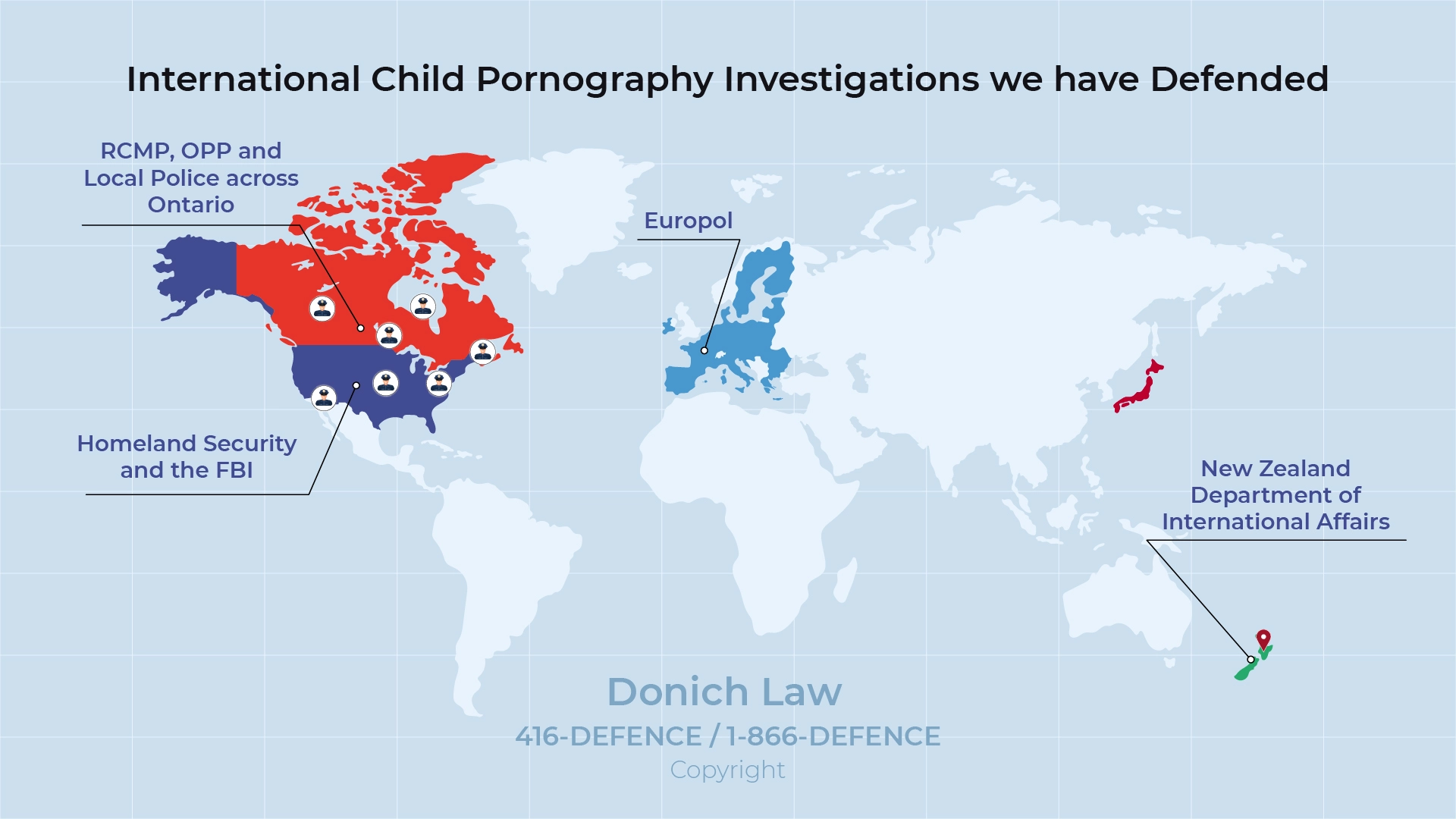
Defend Child Pornography Charges
Crime Statistics
Child pornography offences are serious sex crimes in Canada. Between 2014 and 2020, there were 10,379 cases of online sexual offences against children, and 29,028 incidents where the victim could not be identified. Child sexual offences committed online were more likely to be found guilty with up to 61% of cases resulting in a guilty conviction. There were 11,790 cases of child pornography cases discovered in 2021.
Our Experience
Donich Law has devoted a portion of its practice to defending those charged with internet crimes including internet child exploitation offences. We have successfully defended clients across Ontario in both the Ontario Court of Justice and Superior Court of Justice, regularly securing favourable results. We have worked on cases involving international law enforcement agencies from the United States, New Zealand, and Europe and have experience analysing forensic computer data.
In the case of R. v. M.C. [2022], the Firm successfully defended a client charged with various internet child exploitation offences including distribution of child pornography. The accused’s online activity was flagged by international law enforcement agencies after he shared child pornography material with another user located in Europe. During more than three years of litigation, the Firm launched a section 8 Charter challenge arguing that the police had infringed on the accused’s right against unreasonable search and seizure. The distribution of child pornography material charge was ultimately withdrawn.

- Toronto Star: Pornhub and Revenge Porn.
- Toronto Star: New Corporate Liability for Child Pornography in Canada.
- Toronto Star: Police Power and Social Media Companies.
- Global News: Can an airline tell you to stop recording and delete a cellphone video?
- Métro Montréal: Avec le temps chaud, il n’y a pas que le mercure qui grimpe: le nombre de cas de voyeurisme aussi.
- CityNews: As the temperatures outside get warmer, police say the reported number of cases of voyeurism tend to rise.
- VICE News: An Image Site is Victimizing Women and Little Can be Done.


In the case of R. v. M.O. [2021], the Firm represented an individual arrested and charged after their online activity came to the attention of law enforcement. The individual’s online activity led to him being charged with two counts of possession of child pornography. The Firm spent a considerable amount of time analysing the disclosure provided by the Crown including the Form 1 search warrant used to secure a search warrant in the case. After more than two years of litigation, both charges against the accused were dropped.
In the Firm’s R. v. J.A. [2017], Ontario Police ICE Unit received a Cyber Tip from the National Child Exploitation Coordination Centre (NCECC) and the FBI, who received a complaint from the National Centre for Missing and Exploited Children (NCMEC), located in the United States. Ultimately the Firm secured a withdrawal of both Possession and Distribution of Child Pornography.
Internet Child Exploitation is a Global Problem

Internet Child Exploitation (ICE) Units are specialized departments in many police forces across Ontario. Most larger jurisdictions employ an ICE unit. The units are comprised of a team of officers who are dedicated to fighting child sexual exploitation online. Officers employ various techniques to scan the internet for possible illegal activity and also vet tips from the public and other law enforcement agencies. Officers in ICE units across Ontario are extremely skilled in tracking down suspects online and often utilize sophisticated computer programs to assist them.
The Durham Regional Police has an Internet Child Exploitation (ICE) unit that specializes in investigating child-related sexual offences such as luring, accessing child pornography, possession of child pornography, making of child pornography, and distribution of child pornography. In 2022, the ICE unit reported 513 new investigations, in comparison to 2021 which had 286 investigations. The Durham Regional Police executed 46 search warrants, 28 arrests, and had 94 charges laid against suspects in 2022.
Online Sex Offence are on the Rise in Canada
In the Firm’s R. v. J.T. [2019], the offender was allegedly distributing thousands of child pornography images and videos through peer-to-peer file sharing software. Law enforcement was able to trace artifacts of the accused’s online activity to execute a search warrant. Over two years of litigation, the Firm was able to exclude all but one file of child pornography by challenging the forensic data. This was significantly mitigating for sentencing.
In the Firm’s R. v. E.G. [2014], it was able to challenge the nature of the alleged pornography by proving nearly all images were low resolution thumbnails. This was mitigating and not the same as an offender who is amassing large quantities of child sexual abuse material or distributing it. Factors for sentencing the court will evaluate include the size of the collection, number of videos and nature of the pornography.
Law Newbie is a free AI research assistant that can help you safely answer questions about criminal law.




Frequently Asked Questions
What Are Some Aggravating and Mitigating Factors to Sentencing for Child Porn?
During sentencing, a court may consider aggravating and mitigating factors to determine the length of the sentence. When sentencing child pornography, the primary principle of sentencing is deterrence and denunciation, not rehabilitation. Therefore, jail time is almost always required of the convicted.
As child pornography can often be used as a tool for further sexual offences such as luring and sexual interference, whether the child pornography was shown or distributed to a child or anyone else can be an aggravating factor. The nature and the amount of the collection also plays a significant factor. If the collection depicted violent illegal sexual activity involving children such as sexual interference or bestiality, they are categorized on the more extreme scale of depravity. The more depraved the material, the more aggravating the crime.
Some mitigating factors may include but are not limited to the age of the offender, the character of the offender and/or the remorse of the offender. A mitigating factor specific to child pornography cases is whether the offender had undergone treatment or counselling for any possible disorders related to the crime. Sexual offenders like those convicted of child pornography will also undergo risk assessments that determine if they are a possible threat to children and/or the community. A positive risk assessment is big mitigating factor and may contribute positively to sentencing.
What Are the Primary Sentencing Principles in Oshawa?
The primary sentencing principles for child-related sexual offences are set out in R. v. Friesen, [2020] SCC 9.In the Supreme Court of Canada case of R. v. Friesen, the accused was sentenced to six years by the trial judge. The accused had met a mother on an online dating website, and after having consensual sex with the mother, asked the mother to call her four-year-old daughter into the room. The defendant then sexually assaulted with the child. The trial judge based their decision on R. v. Sidwell, [2015] MBCA 56, that determined the sentencing for major sexual assaults committed against a minor by an adult in a position of trust or authority. The Court of Appeals overturned the sentence, finding that there was no precedent for such a sentence. In the Supreme Court of Canada decision, the Court also took the time to establish firmly the principles of sentencing for child-related sexual offences.
The Court established in Friesen that due to the extreme nature of the crime and inferring from Parliament’s legislative goals of increasing maximum sentences for these offences, denunciation and deterrence would be the primary sentencing principle. The Court also enumerated five “Friesen factors” that could impact sentencing. The offender’s likelihood to reoffend, the offender’s abuse of their position of trust and authority, the duration and frequency of the abuse, the age of the victim, as well as the degree of physical interference may all play a factor in determining the appropriate length of sentence for an offender.
Section 718.01 of the Criminal Code also states that denunciation and deterrence is the primary objective for sentencing. Crimes and offences enumerated in section 718 of the Criminal Code are also subject to the sentencing principles of rehabilitation, which may factor in. A mitigating factor for sentencing in child pornography cases is often the offender’s efforts at counselling.
What Are Ancillary Orders in Durham?
Ancillary orders, or special sentencing orders, are orders by the Court that requires the offender to comply with certain conditions in addition to serving their sentence. They are comparable to bail conditions. Child pornography have some ancillary orders that are mandated and severe. For example, a DNA order will be required by the Court as child pornography is a primary designated offence. This means that the offence is so serious that section 487.04 mandates the taking of the offender’s DNA.
Section 161(1) of the Criminal Code contains a prohibition order specifically for offences concerning children; this order may prohibit the attendance of any public space where children might be, the employment or volunteer opportunity around children, any contact with children, or using the Internet. The Court may apply all or none of section 161, but at their discretion. One of which is internet usage, where some offenders with low risk are allowed some internet usage albeit with limitations.
Are My Rights Infringed? What Are the Charter Challenges Available?
It is important for every Canadian to know their rights. Section 8 of the Canadian Charter of Rights and Freedoms guarantees the right to be secure against unreasonable search and seizure. This is why the police requires a search warrant, signed by the judge, to search a private residence. Often, child pornography cases have concrete forensic evidence that is difficult to defend. However, a Charter challenge may be available.
In the Supreme Court of Canada case of R. v. Morelli, [2010] SCC 8, the accused was acquitted of possession of child pornography. In their decision, the Court did not negate the trial judge nor the appellate judge’s findings of guilt, as the accused was found with evidence. However, the Court did find the search and seizure of the evidence unconstitutional.
In a split 4-3 decision, the Supreme Court of Canada found that the police did not provide reasonable and probable grounds for a search warrant. Since the search warrant is not valid and neither is the search, the accused was acquitted. It is important upon arrest to request a copy of the search warrant. A lawyer may be able to find a fault within the search warrant or the production order to be able to launch a Charter challenge.
Will My Internet Service Provider Provide Information About Me to Police?
Internet Service Provider’s (ISP) are not allowed to provide information about their clients to the police without a production order. For the police to gain information from the internet service provider, the police must obtain a production order, which is an order that mandates a person or organization to disclose documents and records. Section 487.014 of the Criminal Code enumerates the various types and conditions of a production order. Before a production order is made, the justice or judge must be satisfied that the police have reasonable grounds to believe that illegal activity is happening.
If the police have reason to believe that a suspect’s address is interacting with child pornography, they may get a production order and get an individual’s information from their Internet Service Provider. If the internet service provider handed over information without a warrant, it would be unconstitutional and subject to a Charter challenge.
Recent Cases
R. v. R.K.T., 2023 ONSC 1826
The accused was charged with one count of voyeurism, one count of possession of child pornography, one count of making child pornography, and one count of distributing child pornography in the Ontario Superior Court Case of R. v. R.K.T. The accused was alleged to have surreptitiously recorded the complainant while she was in his home, using the bathroom facilities. The accused then was alleged to have shared these images with his male cousin in a Facebook message. Expert analysis of the devices the accused was found with in his home revealed that there were files that contained electronic information that confirmed the accused possessed underage material at the time.
In their analysis, the Court considered the plausibility of the accused committing the act. The accused had the right to be presumed to be innocent until proven guilty. However, given the evidence, the Court was satisfied beyond a reasonable doubt that the accused made recordings of the complainant, knowingly possessed child pornography, made child pornography, and distributed child pornography. The accused was found guilty on all counts.
R. v R. C, 2023 ONSC 2589
The accused was charged with six counts in the Ontario Superior Court of Justice case of R. v. R. C. He was charged with one count of sexual interference, one count of invitation to sexual touching, luring, sexual assault, making child pornography, and possession of child pornography. The accused was a friend of the complainant’s mother and pled not guilty to all charges.
In their decision, the Court considered the testimony of the accused, the complainant, as well as the accused’s wife. According to the principle set out in R. v. W(D), [1991] SCC 93, the testimony must be credible and reliable. If the Court was left in reasonable doubt to whether the accused committed an act, the accused must be acquitted, because the accused has the right to be presumed innocent until proven guilty beyond a reasonable doubt. The complainant was found to be credible and reliable, while the accused’s evidence was unreliable and uncredible. He was found to be dishonest about his relationship with the accused. The accused’s testimony that he did not possess the technology to download images to his phones was also rejected. The accused was found guilty of sexual interference, sexual assault, making child pornography, and possession of child pornography.
R. v J.C, 2023 ONSC 2278
The accused was charged with two counts of sexual assault, two counts of sexual interference, one count of assault and one count of accessing child pornography in the Ontario Superior Court of Justice Case of R. v. J.C. The police discovered 15 images on a desktop computer and 1 image on an external hard drive that the accused admits were child pornography.
To prove that the accused did access child pornography, the Crown had to prove beyond a reasonable doubt that the accused knowingly viewed child pornography or knowingly caused child pornography to be transmitted to himself. Forensic evidence showed that the program used to access child pornography required user input. In addition, no files were found to be downloaded at the same time, so child pornography could not be surreptitiously attached to other downloaded files. The defendant was found guilty on all counts except for the assault.













